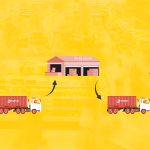Logistics in India cost significantly higher compared to developed countries. This is because almost 60% of inland transportation in India relies on roads, not railways. But, road transportation is expensive due to factors like friction, traffic, and low fuel efficiency. As a result, logistics account for almost 13% of a product’s cost in India, compared to 5-6% in Western countries. To address this, the Indian government is improving infrastructure and taking several initiatives to reduce transportation costs.
One major infrastructure development initiative is the Dedicated Freight Corridor (DFC) project, which involves creating a dedicated railway network solely for cargo transportation. Indian Railways has operationalized over 90 percent of the DFC, covering more than 2,800 kilometres. These corridors aim to enhance efficiency, as rail transport is the second cheapest method among sea, road, rail, and air transport. Additionally, they significantly reduce carbon emissions due to lower fuel consumption, low friction, air drag, and high load-carrying capacity.
Additionally, the government is establishing Multi-Modal Logistics Parks (MMLPs) in 35 key locations across India, near the DFCs. These parks will have advanced facilities to enable seamless cargo transfers between different transport modes.
Advantages of Rail Freight Forwarding
Logistics providers can take advantage of these infrastructure improvements to enhance their operations by making Rail transport one of the primary services for inland transportation of goods. Some of the advantages include,
Fast & Reliable
Since the introduction of Dedicated Freight Corridors (DFCs), the average speed of freight transport by rail has increased substantially, reaching 60 to 65 kmph compared to a mere 25 kmph before the DFCs were implemented. With access to these high-speed and efficient railway services, logistics providers can now offer quicker and more reliable delivery options to their customers, particularly for long-distance routes.
Cost Saving
Rail transport offers significant cost savings compared to road transportation, allowing freight forwarders to pass these savings on to customers and make their services more competitive. Alternatively, they can also reinvest the saved capital into technology and infrastructure improvements, resulting in enhanced service quality.
Eco-Friendly
Indian Railways’ carbon footprint analysis indicates that the Dedicated Freight Corridor (DFC) will produce 2.25 times fewer greenhouse gas emissions over 30 years compared to conventional methods. This highlights the environmental benefits of rail transport over roads. Promoting this sustainability advantage can attract eco-conscious clients and enhance the corporate social responsibility image of logistics providers and their clients.
Strategies for a Seamless Transition to Rail Logistics Services
Transitioning from road to rail transport might pose challenges initially for logistics companies accustomed to road-based operations. However, employing the following strategies can streamline the transition process, ultimately benefiting both the logistics firms and their clients.
Invest in Technology and Infrastructure
To optimise last-mile delivery, logistics providers can prioritise the integration of RFID chips and other tracking technologies. This investment not only enhances inventory management, reduces loss and theft, and improves overall service reliability but also facilitates the seamless transition of goods from roads to rails and vice versa, leveraging the efficiency and cost-effectiveness of railway transportation.
Enhance Last-Mile Delivery
While rail can handle long-distance transport, the final leg of delivery still requires road transport. Logistics providers can focus on strengthening their last-mile delivery networks to ensure timely and efficient delivery from rail terminals to end destinations.
Prioritise Training and Development
Logistics companies can Invest in training staff to manage and operate within a rail-centric logistics framework. Understanding the nuances of rail transport will be crucial for optimising operations and service delivery.
In conclusion, India’s logistics advancements, notably the Dedicated Freight Corridor (DFC) project and Multi-Modal Logistics Parks (MMLPs), offer a substantial opportunity for third-party logistics providers. By integrating rail, leveraging cost savings, investing in technology, prioritising sustainability, enhancing last-mile delivery, and staff training, Logistics providers can enhance operations, reduce costs, and align with global sustainability goals, providing competitive, reliable, and eco-friendly services to clients.



